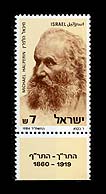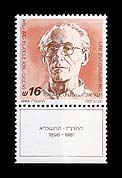|
Michael Halprin was born in Vilna in the year 1860 into a very wealthy and learned family. He received a traditional Jewish education and from a very early age became a fervent nationalist and public benefactor and one of his earliest acts was to take steps to care for Jewish prostitutes and help them make a new life for themselves. He also set up a co-operative workshop in which he engaged Jewish workers who were miserably employed in privately-owned undertakings.
Following the pogroms of 1880, he devoted himself full-time to the Hibbat Zion ("Love of Zion") movement and in 1 885 decided to emigrate to Eretz Israel. On the eve of his departure he entered the synagogue, took a Scroll of the Law in his hands and swore to devote all his wealth to the well-being of Eretz Israel and took an oath "If I forget thee, O Jerusalem, may my right hand lose its cunning".
Upon his arrival in the Holy Land he participated in the redemption of the soil of Yesud Ha-Maala and purchased the soil of Nes Ziyyona with the intention of founding a workers' village on the site but was unable to carry out his plans because of financial difficulties. On the day that Nes Ziyyona was officially founded, Michael Halprin appeared on the scene bearing a blue and white flag in his hands and accompanied by a company of horsemen.
When in 1891 a ban on the entry of Jews to the Holy Land was declared he demonstrated against the edict by riding the streets of Jaffa on an Arab holiday carrying the Zionist flag and accompanied by a troop of horsemen loudly singing the hymn of the First Aliya 'Carry the banner to Zion, the banner of the camp of Judah". When the group reached the hill on which Nes Ziyyona stood, he drew his sword and cried out "I dedicate this sword to the Lord" and cut his right hand, drawing blood, to signify that only through the sword and bloodshed could Eretz Israel be redeemed.
About the same period, Michael Halprin founded the first Workers' Organization in Eretz Israel and declared open war on the officials of Baron de Rothschild for their actions in the colonies that were under the aegis of the Baron. This led to open rebellion against the Baron's officials and as a result, Halprin was forced to leave the country for a few years, returning in 1898. He took part in a number of Zionist Conferences abroad where he appeared dressed in a red shirt "as befits a representative of the Zionist proletariat."
He then spent a number of years in Europe and returned to Eretz Israel in 1906 swearing that he would never again return to Russia. He returned a poor man, having spent or wasted all his wealth and took a job as a night watchman, first in Jaffa, and then when Tel Aviv was founded, at the Herzlia Gymnasium.
Halprin was an effective orator and also wrote a number of Yiddish dramas and poems full of love for the Land of Israel, but all his manuscripts went up in flames in the attack on Tel Hai.
He founded "Ha-Shomer" (the Watchmen's Organization) and the Poale Zion (Zionist Workers) Party and devoted himself full-time to these organizations.
When in 1918 Allenby began the conquest of Palestine and volunteers formed the Jewish Legion, he went to volunteer but was turned down on account of his age. Scarcely a few months before his death he began to consider the possibility of organizing a Jewish army to conquer the country so that it could provide a refuge for all persecuted Jews.
During and after the war he suffered greatly from ill-health and poverty. He went to live in the Upper Galilee but there he was sick, alone and forsaken. He died in Zefat in the year 1920 and was buried at Mahanayim.
A village near Nes Ziyyona was named after him - Giv'at Michael (Michael's Hill) and a street in Tel Aviv bears his name.
Uri Zvi Grinberg, one of the great Hebrew poets of the 20th century, was born in Galicia in the year 1896, the direct descendant of a family of rabbis from whom he drew his inspiration.
His first works in Hebrew and Yiddish were published in 191 2 and he was quickly accepted into the ranks of the leading writers in both tongues. His first book, in Yiddish, was published in Lwow while he was fighting on the Serbian front. His most important Yiddish book was the poem "Mefisto". He also edited an innovative literary journal "Albatross".
Upon immigrating to Israel in 1923, Uri Zvi Greenberg declared that in future he would write only in Hebrew, but he found it difficult to cut himself off from his mother-tongue, Yiddish, and continued to write in that language from time to time.
His poems and articles appeared in the labour press. He spent his time travelling around the country, visiting the pioneer settlements in which he saw the fulfilment of his dreams.
After the disturbances of 1929, he left the workers' movement and joined up with the Revisionists. This dramatic change was the outcome of his dissatisfaction with the leaders of the Yishuv who, he claimed, had abandoned their ideals of a revival of the Kingdom of Israel and failed to recognize the dangers inherent in the spread of Arab nationalism.
He became an active member of the Revisionist movement and undertook a mission for the party in Poland, returning to Israel on the outbreak of the second World War. During the thirties he attacked the official policy of "Restraint" and called for the setting up of a Jewish military force that would keep the Arabs in check and free Eretz Israel from British rule. He expressed this in a number of his poems in which he called upon the people "not to die for the sanctification of God, but defend ourselves and establish the Kingdom of Israel." These poems were the inspiration of the Underground as they fought to bring their dreams to life.
As far back as 1923, Uri Zvi Greenberg foresaw the destruction of European Jewry, and in his poems and articles he warned of the fate in store for the Jews of the Diaspora. After the Holocaust he mourned over the fact that his terrible prophecies had been realised. Uri Zvi Greenberg was elected a member of Israel's first Knesset, representing the Herut party, and until his death in 1981 was active in the public struggle for a "Greater Israel", the redemption of Jerusalem and the realisation of his royalist dreams.
In his works he takes the Christian world to task for turning Europe into a slaughterhouse for Jews and attacks the Arabs for their acts of savagery. He strives for a "Jewish Revolution" that will renew the ties between the Jewish people, their homeland and their traditions, and gives vent to the yearnings for a revival of the Kingdom of Israel and the redemption of the Jewish people. His works represent a synthesis of traditional Jewish values and an individualistic lyrical approach to life and its problems. Thus while his works clearly owe much to such traditional Jewish sources as the Bible, the Talmud, the prayer book, etc., a certain European influence also makes itself felt.
His Hebrew poetry has been published in a number of books including "Rehovot Ha-Nahar" (Streets of the River) which contains poems on the Holocaust, but there still remain a considerable number of his poems that have not yet been collated.
Throughout the long years of his work as author and publicist, Uri Zvi Greenberg had a wide circle of admirers who saw in him "a poet-legislator", as well as numerous vociferous detractors who opposed his views and his vision, but both groups were united in agreeing on his eminence as a poet. All his life, Uri Zvi Greenberg strove to be "a venerable Jerusalemite" and felt himself to be "a representative of the Kingdom that is still no more than a burning vision".


